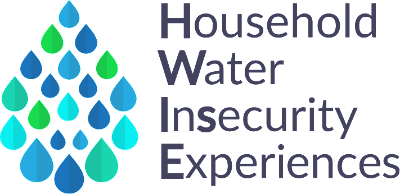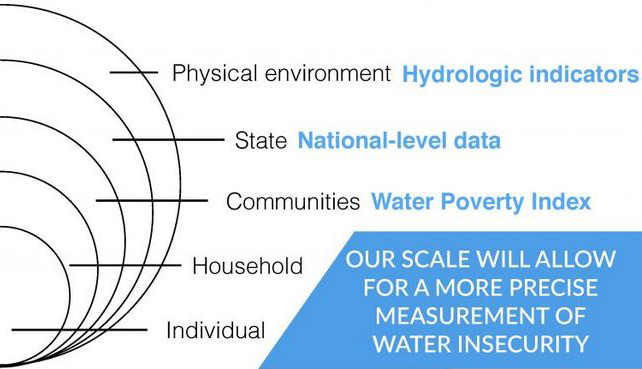Theme 4: Global Water Insecurity
Research Study: Household Water InSecurity Experiences (HWISE)
Study Designs and Aims
 The purpose of this work is to develop a cross-cultural scale to assess household-level water insecurity that can be used across many ecological and geographic
settings. To do this, an initial set of water insecurity questions related to the sub-domains of physical health, consumption, quantity, access and acquisition,
cultural importance, and social considerations were tested in over 10 countries. These data were then used to refine the scale. Ultimately, the scale will
resemble the Household Food Insecurity Access Scale (HFIAS) and the Latin American & Caribbean Household Food Security Measurement Scale (ELCSA), i.e. questions
will ask the frequency that water-related activities could not occur in the prior month due to lack of water (e.g. not watering crops, going to sleep thirsty, etc.).
The purpose of this work is to develop a cross-cultural scale to assess household-level water insecurity that can be used across many ecological and geographic
settings. To do this, an initial set of water insecurity questions related to the sub-domains of physical health, consumption, quantity, access and acquisition,
cultural importance, and social considerations were tested in over 10 countries. These data were then used to refine the scale. Ultimately, the scale will
resemble the Household Food Insecurity Access Scale (HFIAS) and the Latin American & Caribbean Household Food Security Measurement Scale (ELCSA), i.e. questions
will ask the frequency that water-related activities could not occur in the prior month due to lack of water (e.g. not watering crops, going to sleep thirsty, etc.).
Our ability to measure food security at the household has been transformative for our understanding of the underlying causes of a range of poor health and nutrition outcomes, from depression and poor mental health to HIV. It has also been useful for developing interventions and policies to mitigate food insecurity, and has helped to elucidate why some interventions have not had their intended effects.
Water security, or “the ability to reliably access water in sufficient quantity and quality for all household members to support an active and health life” is critical for optimal agricultural productivity, nutrition and health. Currently, there is no cross-culturally reliable and valid scale to measure water insecurity at the household-level. We will use rigorous techniques to develop and validate such a scale. This study involves study teams in over 20 countries, and is led by Dr. Sera Young, Dr. Wendy Jepson and Dr. Amber Wutich. Dr. Pearson is on the Steering Committee and led data collection efforts in Arua, Uganda (with Dr. Gershim Asiki) and in Mérida, Mexico (with Dr. Cuau Sanchez).
Findings
In thinking through what water insecurity means, researchers in the consortium have argued for a relational approach to understanding water insecurity and how this type of thinking might move beyond a focus on the presence of the object (H2O) of water and turn our focus to the political structures and social processes through which water is secured. Current methods to define and address water insecurity are widely recognized to oversimplify and underestimate the global burden of household water insecurity. To move forward, entitlements and human capabilities, socio-cultural dynamics, and political institutions and processes should be considered, which can be adopted across cultural, geographic, and demographic contexts to assess hard-to-measure dimensions of household water insecurity.

Image from HWISE
Precarity: Water and Power
An Exhibit in the DEPTH exhibition at the Science Gallery Detroit
 Precarity exists when people have little predictability in their day-to-day living conditions, including the water they need to survive
and live a quality life. When power is uneven, political will fails, or economic systems do not prioritize safe and accessible water,
people live with, and through, precarity. In examining the real cause and effect of water access in places such as Bolivia, Kenya, Uganda,
Ghana, South Africa, Mexico, Flint, and more, participants will carry a jerrycan filled with rocks to a simulated destination point. Upon
arrival, visitors learned facts that spotlight the reality of the worldwide water crisis.
Precarity exists when people have little predictability in their day-to-day living conditions, including the water they need to survive
and live a quality life. When power is uneven, political will fails, or economic systems do not prioritize safe and accessible water,
people live with, and through, precarity. In examining the real cause and effect of water access in places such as Bolivia, Kenya, Uganda,
Ghana, South Africa, Mexico, Flint, and more, participants will carry a jerrycan filled with rocks to a simulated destination point. Upon
arrival, visitors learned facts that spotlight the reality of the worldwide water crisis.
The exhibit was available at the Science Gallery Detroit from June 6th 2019 until August 17th 2019.